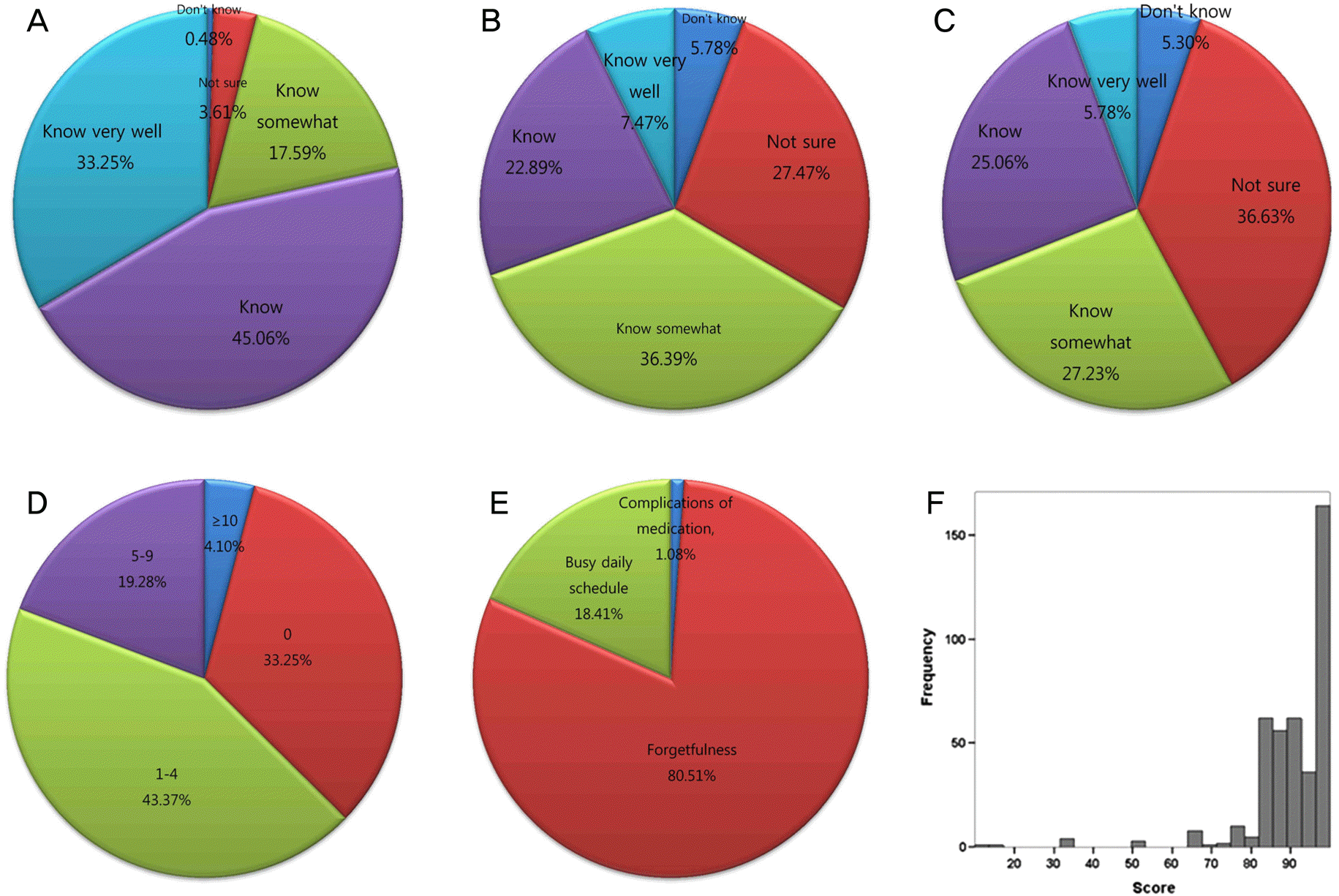초록
Methods:
This study was performed via a structured questionnaire given to 415 glaucoma patients using eye drops for glaucoma treatment. The degree of compliance was evaluated by using compliance score (range, 0–100) which was calculated based on the number of days of missing medication per month. The degree of symptoms and complications related to glaucoma and its medication were investigated using the Glaucoma Symptom Scale (GSS). The effect of sex, age, treatment duration, knowledge about the glaucoma medication, number of eye drops, class of glaucoma medication, family support for eye drop use, and GSS on glaucoma medication compliance was assessed.
Results:
The most frequently found number of days of missing medication per month was one to four (43.4%). The most common reason for missing medication was forgetfulness (80.5%), followed by busy daily schedule (18.4%) and complications of medication (1.1%). Compliance score ranged from 10.0 to 100.0 (median value, 90.0). Older age, longer duration of treatment, higher knowledge about the glaucoma medication, and the presence of family support was significantly associated with a higher compliance score ( p < 0.05). Sex, number and class of eye drops, and GSS did not significantly affect compliance score.
Go to : 
References
1. Kass MA, Heuer DK, Higginbotham EJ, et al. The Ocular Hypertension Treatment Study: a randomized trial determines that topical ocular hypotensive medication delays or prevents the onset of primary open-angle glaucoma. Arch Ophthalmol. 2002; 120:701–13. discussion 829-30.
2. Leske MC, Heijl A, Hussein M, et al. Factors for glaucoma progression and the effect of treatment: the early manifest glaucoma trial. Arch Ophthalmol. 2003; 121:48–56.
3. Ahn DH, Lee YG, Hong YJ. Factors affecting compliance with prescribed eyedrops for glaucoma. J Korean Ophthalmol Soc. 1998; 39:2145–51.
4. Park MH, Kang KD, Moon J; Korean Glaucoma Compliance Study Group. Noncompliance with glaucoma medication in Korean patients: a multicenter qualitative study. Jpn J Ophthalmol. 2013; 57:47–56.

5. Taylor SA, Galbraith SM, Mills RP. Causes of noncompliance with drug regimens in glaucoma patients: a qualitative study. J Ocul Pharmacol Ther. 2002; 18:401–9.

6. Robin A, Grover DS. Compliance and adherence in glaucoma management. Indian J Ophthalmol. 2011; 59(Suppl):S93–6.

7. Kholdebarin R, Campbell RJ, Jin YP, Buys YM. Multicenter study of compliance and drop administration in glaucoma. Can J Ophthalmol. 2008; 43:454–61.

8. Friedman DS, Okeke CO, Jampel HD, et al. Risk factors for poor adherence to eyedrops in electronically monitored patients with glaucoma. Ophthalmology. 2009; 116:1097–105.

9. Ngan R, Lam DL, Mudumbai RC, Chen PP. Risk factors for noncompliance with follow-up among normal-tension glaucoma suspects. Am J Ophthalmol. 2007; 144:310–1.

10. Norell SE. Improving medication compliance: a randomised clinical trial. Br Med J. 1979; 2:1031–3.

11. Friedman DS, Hahn SR, Gelb L, et al. Doctor-patient communication, health-related beliefs, and adherence in glaucoma results from the Glaucoma Adherence and Persistency Study. Ophthalmology. 2008; 115:1320–7. 1327.e1-3.
12. Robin AL, Covert D. Does adjunctive glaucoma therapy affect adherence to the initial primary therapy? Ophthalmology. 2005; 112:863–8.

13. Olthoff CM, Schouten JS, van de Borne BW, Webers CA. Noncompliance with ocular hypotensive treatment in patients with glaucoma or ocular hypertension an evidence-based review. Ophthalmology. 2005; 112:953–61.
14. Cooper J. Improving compliance with glaucoma eye-drop treatment. Nurs Times. 1996; 92:36–7.
15. Sleath BL, Blalock SJ, Muir KW, et al. Determinants of Self- Reported Barriers to Glaucoma Medicine Administration and Adherence: A Multisite Study. Ann Pharmacother. 2014; 48:856–62. [Epub ahead of print].
16. Ashburn FS Jr, Goldberg I, Kass MA. Compliance with ocular therapy. Surv Ophthalmol. 1980; 24:237–48.

17. Lee BL, Gutierrez P, Gordon M, et al. The Glaucoma Symptom Scale. A brief index of glaucoma-specific symptoms. Arch Ophthalmol. 1998; 116:861–6.
Go to : 
 | Figure 1.Distribution of knowledge about the glaucoma medication (A: how to use medi cation; B: possible complications of medication; C: expiration date of medication), number of days with missing of medication per month (D), causes of missing (E), and compliance score (F). |
Table 1.
Clinical data of patients
Table 2.
Distribution of compliance score (number of days with missing of medication per month)
Table 3.
Distribution of glaucoma symptom scale items




 PDF
PDF ePub
ePub Citation
Citation Print
Print


 XML Download
XML Download